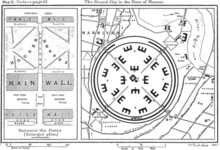
The Palace of the Golden Gate ( Arabic: قصر باب الذهب, romanized: Qasr Bāb al-Dhahab) or Palace of the Green Dome ( Arabic: قصر القبة الخضراء, romanized: Qasr al-Qubbat al-Khaḍrāʾ) was the official caliphal residence in Baghdad during the early Abbasid Caliphate.
Baghdad was founded in 762 by the second Abbasid caliph, al-Mansur ( r. 754–775). The main part of the original city was the Round City, with the Palace of the Golden Gate and the adjacent Great Mosque of al-Mansur at its centre. [1] Apart from the mosque, no other buildings were allowed to be built close to the palace, which was thus surrounded by a wide open space; only on the northwest, towards the Gate of Syria, two buildings were constructed next to the palace wall: a barracks for the caliph's horse guard, and a two-part gallery, originally intended as an audience hall for the sahib al-shurta (police chief) and the captain of the horse guard respectively, but later came to be used as a public prayer space. [2] Around this space, the palaces of al-Mansur's younger children, quarters for the palace servants, and the offices of the various administrative departments were built. [3]
The palace originally occupied an area of 200 square yards (170 m2), with a central building topped by a green dome, 48.36 metres (158.7 ft) high, which gave the palace its alternative name of al-Qubbat al-Khadra'. [3] [4] At the top of the dome was the effigy of a horseman carrying a lance, who in later times was credited with magical properties: he would allegedly turn his lance towards the direction where enemies were approaching from. [3] Underneath the dome was a square audience chamber 30 feet (9.1 m), with a vaulted ceiling just as high; and above that, in the interior of the dome, was another chamber of similar dimensions. [5] In front of the audience chamber was an alcove, called the aywan, which was surmounted by an arch 45 feet (14 m) high and 30 feet (9.1 m) wide. [5]
The palace and mosque appear to have been completed in 763, one year after construction began, allowing al-Mansur to take up residence in the city. [4] While the Palace of the Golden Gate remained the official residence of the caliphs, al-Mansur and his successors also spent much time in the nearby Khuld Palace constructed soon afterwards. [5] Caliph Harun al-Rashid ( r. 786–809) is said to have particularly preferred Khuld over the older palace, but his son al-Amin ( r. 809–813) restored it as his residence, added a new wing to it, as well as a large square (maydan). [4] [5] As the main stronghold of al-Amin and his partisans, it suffered extensive damage from bombardment by catapult during the Siege of Baghdad (812–813). The palace then ceased to be used as a royal residence, and became neglected. [4] [6]
The palace remained intact, although part of the structure was torn down to facilitate the expansion of the nearby Great Mosque under al-Mu'tadid ( r. 892–902). The landmark Green Dome remained standing until the night of 9 March 941 (7/8 Jumada II 329 AH), when heavy rainfalls, and possibly a thunderbolt strike, led to its collapse. [4] [7] The walls of the dome survived until the Sack of Baghdad by the Mongols in 1258. [4]
References
- ^ Le Strange 1900, pp. 15–19.
- ^ Le Strange 1900, pp. 30–31.
- ^ a b c Le Strange 1900, p. 31.
- ^ a b c d e f Duri 1960, p. 896.
- ^ a b c d Le Strange 1900, p. 32.
- ^ Le Strange 1900, pp. 32–33.
- ^ Le Strange 1900, p. 33.
Sources
- Duri, A. A. (1960). "Baghdād". In Gibb, H. A. R.; Kramers, J. H.; Lévi-Provençal, E.; Schacht, J.; Lewis, B. & Pellat, Ch. (eds.). The Encyclopaedia of Islam, Second Edition. Volume I: A–B. Leiden: E. J. Brill. pp. 894–908. doi: 10.1163/1573-3912_islam_COM_0084. OCLC 495469456.
- Le Strange, Guy (1900). Baghdad During the Abbasid Caliphate. From Contemporary Arabic and Persian Sources. Oxford: Clarendon Press. OCLC 257810905.